Create a multi-tenant, whitelabel application in Elixir & Phoenix part II: Dynamic subdomain routing
- 10 minsThis blog post originally appeared on the Red Squirrel Blog.
In the previous post we outlined what a multi-tenant whitelabel application is. We also got our hands dirty by creating a new Phoenix application where we added the foundations for the app to be accessible via different sub-domains as well as a root domain.
The posts in these series are:
- Part I: Working with subdomains
- Part II: Dynamic subdomain routing
- Part III: Adding accounts tenants
In this article we will extend our app to use a custom router and dispatch subdomain requests to a separate controller which then loads different pages than our root domain.
Adding subdomain routing
In the last post we went through the concept of adding a custom plug to capture a given subdomain and store it in the connection struct (conn). We then used that information to display different data on the same page. We’ll take this a step further now by adding the necessary code to display a different page altogether.
Our code from last time uses the same router and serves the same page albeit with different data for requests coming from both the root domain and a subdomain. We want requests coming from a subdomain to be handled by a different router.
Let’s head back to our project and add a new file under the lib/fresco_web directory called subdomain_router.ex. Add the following code inside of it:
# lib/fresco_web/subodomain_router.ex
defmodule FrescoWeb.SubdomainRouter do
use FrescoWeb, :router
pipeline :browser do
plug :accepts, ["html"]
plug :fetch_session
plug :fetch_live_flash
plug :put_root_layout, {FrescoWeb.LayoutView, :root}
plug :protect_from_forgery
plug :put_secure_browser_headers
end
pipeline :api do
plug :accepts, ["json"]
end
scope "/", FrescoWeb.Subdomain do
pipe_through :browser
get "/", PageController, :index
end
end
You might think this looks identical to the existing router found under lib/fresco_web/router.ex and you are largely correct. The main difference is on the line starting with scope. This is the code from lib/fresco_web/router.ex:
scope "/", FrescoWeb do
pipe_through :browser
get "/", PageController, :index
end
In our new router, we’re scoping the incoming queries to a different context called Subdomain :
scope "/", FrescoWeb.Subdomain
Note: You might be thinking “Why do I need another router? Can’t I do all of that in same router?”. You probably can but there are some good reasons to have separate routers:
- Clearer code organisation and separation
- Smaller modules
- Easier/quicker to conceptually parse vs a single file with mixed responsibilities
- Custom configuration (i.e pipelines, plugs etc) can be added that’s only applicable to routing subdomains or vice verca
Now that we have a subdomain router, let’s use it. Open the endpoint file lib/fresco_web/endpoint.ex and change the line where we added our subdomain plug and change this code:
plug FrescoWeb.Plugs.Subdomain
to this:
plug FrescoWeb.Plugs.Subdomain, %{ subdomain_router: FrescoWeb.SubdomainRouter }
Previously our Subdomain plug was initialised without any additional options. Now we’re passing additional options, in this case a map, containing our newly created SubdomainRouter. This means we also need to change our code in the plug subdomain file lib/fresco_web/plugs/subdomain.ex to make use of this change:
defmodule FrescoWeb.Plugs.Subdomain do
@behaviour Plug
import Plug.Conn, only: [put_private: 3]
# we will use the options parameter and merge the incoming options with the existing one
def init(opts) do
Map.merge(
opts,
%{ root_host: FrescoWeb.Endpoint.config(:url)[:host] }
)
end
# unpack subdomain_router argument
def call(%Plug.Conn{host: host} = conn, %{root_host: root_host, subdomain_router: router}) do
case extract_subdomain(host, root_host) do
subdomain when byte_size(subdomain) > 0 ->
put_private(conn, :subdomain, subdomain)
|> router.call(router.init({})) # <--- call the router with the incoming connection
_ ->
conn
end
end
defp extract_subdomain(host, root_host) do
String.replace(host, ~r/.?#{root_host}/, "")
end
end
Restart the Phoenix server, visit a subdomain like http://green.fresco.com:4000/ and you should be greeted with….an error:
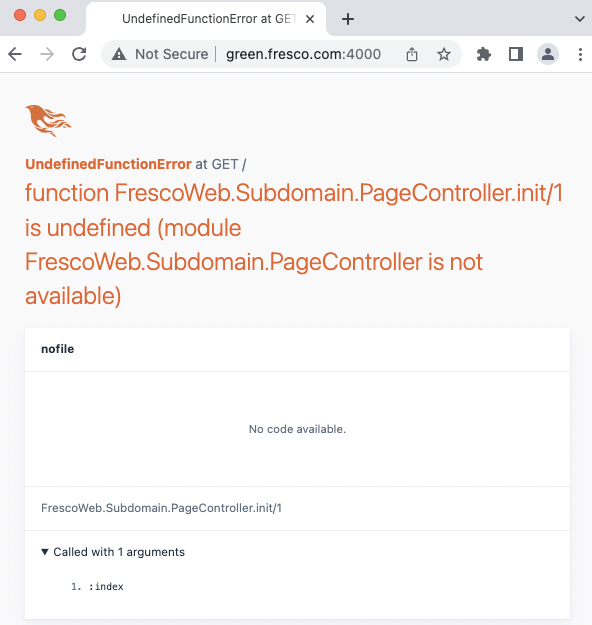
Remember this line scope "/", FrescoWeb.Subdomain in our SubdomainRouter? Since the requests are now scoped to a Subdomain namespace, our app is looking for a PageController in that namespace.
Create a new directory under lib/fresco_web/ called subdomain:
mkdir lib/fresco_web/subdomain
Inside of that new directory, create a file called page_controller.ex and add the following code:
defmodule FrescoWeb.Subdomain.PageController do
use FrescoWeb, :controller
def index(conn, _params) do
render(conn, "index.html", %{subdomain: conn.private[:subdomain]})
end
end
Refresh the page in the browser. Indeed, another error greets us:
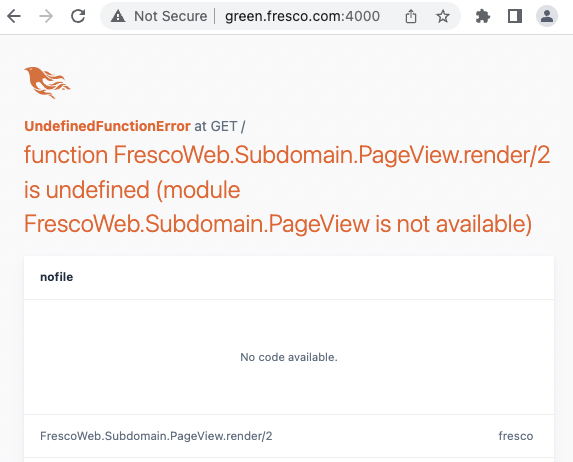
The error, like before, it’s telling us the next action we need to take. Since now our Subdomain.PageController is used, during the render function call it’s trying to find a View (PageView) that’s under the same namespace (Subdomain). Create a new directory called subdomain under lib/fresco_web/views/ and a new a file inside of that called page_view.ex:
mkdir lib/fresco_web/views/subdomain
touch lib/fresco_web/views/subdomain/page_view.ex
and add the following code inside of it:
defmodule FrescoWeb.Subdomain.PageView do
use FrescoWeb, :view
end
Refresh the page http://green.fresco.com:4000/ and:
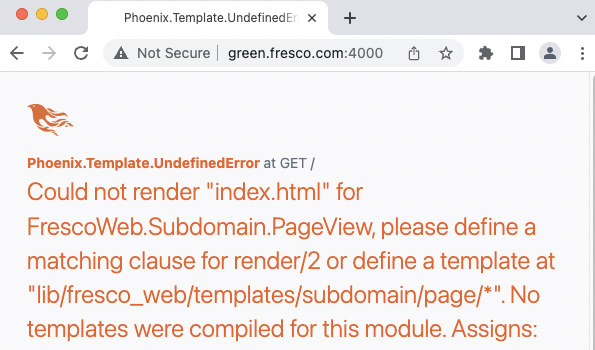
I’m not trolling you, I promise. The reason I’m taking you on this journey is to show the “invisible” connecting dots between the different components that would otherwise be less obvious had I given you all of the code up front and skipped the step by step process.
We’re almost there, one more file:
# create recursively two directories: subdomain and inside of it, page
mkdir -p lib/fresco_web/templates/subdomain/page/
# the file our error is looking for
touch lib/fresco_web/templates/subdomain/page/index.html.heex
Inside our new file lib/fresco_web/templates/subdomain/page/index.html.heex add the following:
<section class="phx-hero">
<h1><%= gettext "Welcome to %{name}!", name: @subdomain %></h1>
<p>Peace of mind from prototype to production</p>
</section>
<section class="row">
<article class="column">
<h2>Resources</h2>
<ul>
<li>
<a href="https://hexdocs.pm/phoenix/overview.html">Guides & Docs</a>
</li>
<li>
<a href="https://github.com/phoenixframework/phoenix">Source</a>
</li>
<li>
<a href="https://github.com/phoenixframework/phoenix/blob/v1.6/CHANGELOG.md">v1.6 Changelog</a>
</li>
</ul>
</article>
</section>
Refresh the page at http://green.fresco.com:4000/ and voila:
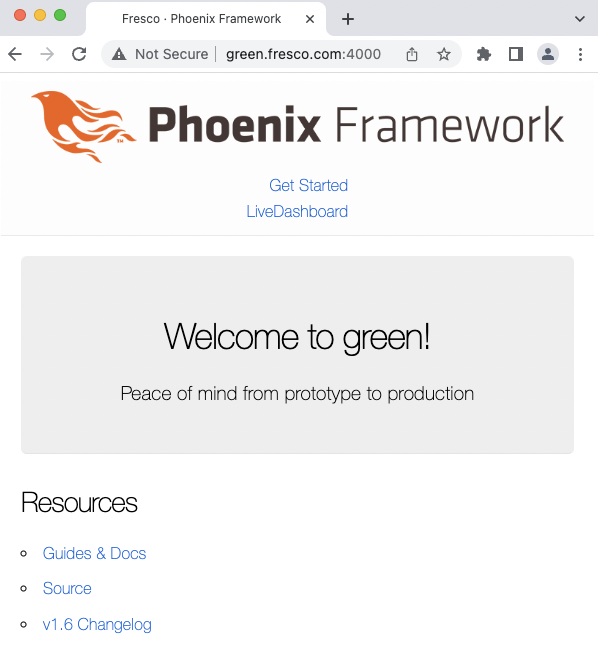
Let’s refresh the other pages as well, our root domain http://fresco.com:4000/ and our other subdomain http://farm.fresco.com:4000/. You should see the sweet image of success:
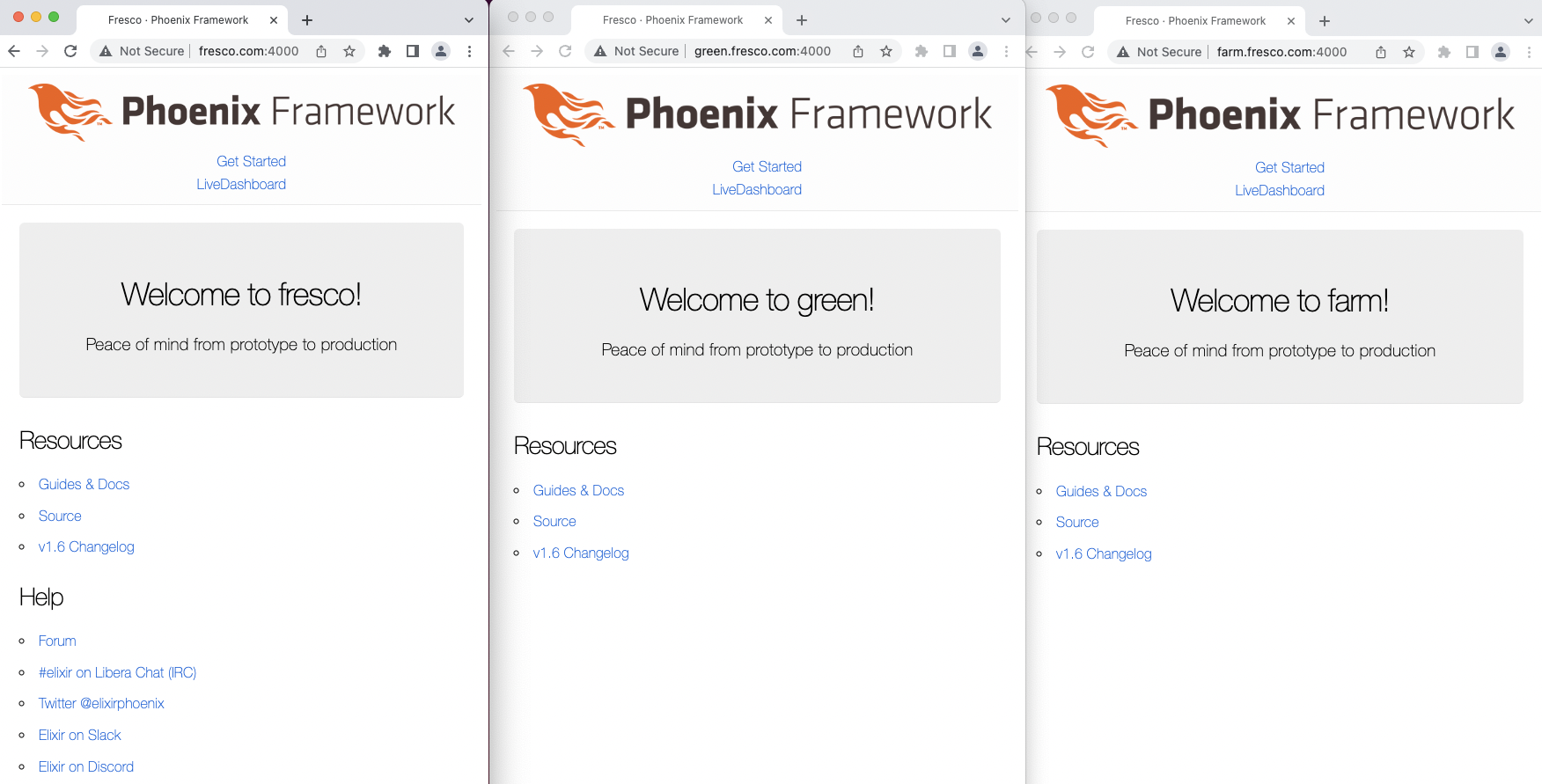
As you can see, our root domain apart from a different greeting it also displays the additional “Help” section since it’s been handled by a different controller that renders a different template.
Let’s address something you may have noticed in your server logs back in the terminal. More specifically this error:
[info] GET /
[debug] Processing with FrescoWeb.Subdomain.PageController.index/2
Parameters: %{}
Pipelines: [:browser]
[info] Sent 200 in 1ms
[debug] Processing with FrescoWeb.PageController.index/2
Parameters: %{}
Pipelines: [:browser]
[error] #PID<0.678.0> running FrescoWeb.Endpoint (connection #PID<0.647.0>, stream id 8) terminated
Server: farm.fresco.com:4000 (http)
Request: GET /
** (exit) an exception was raised:
** (Plug.Conn.AlreadySentError) the response was already sent
(phoenix 1.6.15) lib/phoenix/controller.ex:570: Phoenix.Controller.put_root_layout/2
(fresco 0.1.0) FrescoWeb.Router.browser/2
(fresco 0.1.0) lib/fresco_web/router.ex:1: FrescoWeb.Router.__pipe_through0__/1
(phoenix 1.6.15) lib/phoenix/router.ex:346: Phoenix.Router.__call__/2
(fresco 0.1.0) lib/fresco_web/endpoint.ex:1: FrescoWeb.Endpoint.plug_builder_call/2
(fresco 0.1.0) lib/plug/debugger.ex:136: FrescoWeb.Endpoint."call (overridable 3)"/2
(fresco 0.1.0) lib/fresco_web/endpoint.ex:1: FrescoWeb.Endpoint.call/2
(phoenix 1.6.15) lib/phoenix/endpoint/cowboy2_handler.ex:54: Phoenix.Endpoint.Cowboy2Handler.init/4
(cowboy 2.9.0)
Remember the change we did in our endpoint file where we added our Subdomain plug right before the Router plug:
plug FrescoWeb.Plugs.Subdomain, %{ subdomain_router: FrescoWeb.SubdomainRouter }
plug FrescoWeb.Router
Because our Subdomain plug now calls our new SubdomainRouter a response is sent already from the server. Our Subdomain plug then returns the conn struct which is then passed to the FrescoWeb.Router which in turn tries to send a response as well causing the above error. We can fix this error by using the halt function to prevent any further plus futher down the pipeline (i.e FrescoWeb.Router) from executing:
defmodule FrescoWeb.Plugs.Subdomain do
@behaviour Plug
import Plug.Conn, only: [put_private: 3, halt: 1] # import the function
...
def call(%Plug.Conn{host: host} = conn, %{root_host: root_host, subdomain_router: router}) do
case extract_subdomain(host, root_host) do
subdomain when byte_size(subdomain) > 0 ->
put_private(conn, :subdomain, subdomain)
|> router.call(router.init({}))
|> halt() # <--- halt further execution
_ ->
conn
end
end
...
end
That’s it, we did it. We removed the final error and our app is capable of handling requests from different domains and passing them to the appropriate router to handle. There is a lot of information to take in and explore further in this post so give yourself a pad on the back and a well-deserved break.
In our next post we’ll take this ability to dynamically display custom content a step further with the introduction of user accounts aka tenants!
